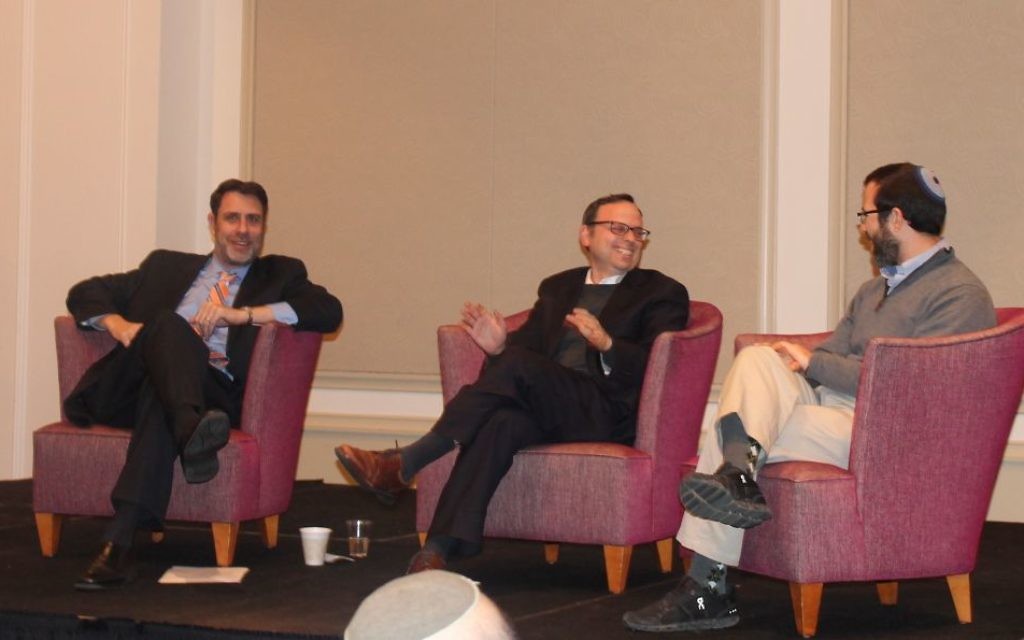No Joke: 3 Rabbis Walk Into a Shared Future
A class recently compared the Modern Orthodoxy of Young Israel, Conservative Judaism of Shearith Israel and Reform Judaism of The Temple.

Three rabbis from three Atlanta congregations representing three Jewish movements helped 33 students learn through three months of study that Judaism’s denominations can coexist and agree far more than they disagree.
“We’re no longer each other’s competition or enemies or anything close to that because the biggest challenge we all share is the largest denomination,” those Jews who don’t have a spiritual home at all, Young Israel of Toco Hills Rabbi Adam Starr said. “I think we all appreciate that each of us is able to reach different people in different places, and we want to make more Jews, and even if it’s not the way we personally would do it, we appreciate that more people are being reached.”
Under the auspices of the Marcus JCC’s Lisa F. Brill Institute for Jewish Learning and the Florence Melton School of Adult Jewish Learning, Rabbi Starr took turns with Rabbi Peter Berg of The Temple and Rabbi Ari Kaiman of Congregation Shearith Israel in leading a combined class of their congregants in a new course, “Jewish Denominations: Addressing the Challenges of Modernity.”
Get The AJT Newsletter by email and never miss our top stories Free Sign Up
As its name indicates, the course compared the Modern Orthodoxy of Young Israel, Conservative Judaism of Shearith and Reform Judaism of The Temple, but the finale Dec. 11 at The Temple marked the first time the three rabbis faced the class at the same time.
“There are so many things that we have in common. This whole course was meant to be a celebration of that which we share together,” Rabbi Berg said.
Among those things:
- Diversity. Rabbi Berg said diversity is a strength within his congregation and across Atlanta’s rabbinic community, which he said is unusual in the United States in its willingness to sit down together and discuss issues respectfully.
“If we’re not going to close our world, we’re going to experience diversity, and diversity is going to challenge us to expand what we think is possible,” Rabbi Kaiman said.
He said that when he teaches, he presents what is compelling, valuable and important to him without the expectation that it will be a perfect fit for others. “I teach it as an option. I teach it as a way. And it’s a pretty awesome way.”
Diversity works as long as you first know who you are and what you believe, Rabbi Starr said. “We certainly value diversity. But when I’m teaching in my synagogue and I’m preaching, I’m teaching and preaching my general understanding of what G-d and Torah demand of us, which would be different from different movements.”
- Multiple definitions of a Jew. The U.S. Reform movement’s acceptance of patrilineal descent since 1991 doesn’t create as dramatic a split in practice as on paper.
Reform rabbis are strict in applying patrilineal rules only when a child has a Jewish upbringing, Rabbi Berg said, and The Temple still encourages those Jews to go through formal conversion.
Rabbis Starr and Kaiman recognized two kinds of Jews: those who are halachically Jewish and those who identify as Jewish.
While only halachic Jews — those born to a Jewish mother or converted according to Jewish law — may participate in religious honors and rites at Young Israel and Shearith, that doesn’t mean others aren’t welcome in the communities.
“If you identify as a Jew, I will talk to you as a Jew,” Rabbi Starr said.
“In your own eyes, of course you’re Jewish,” Rabbi Kaiman said. “And in G-d’s eyes, who knows?”
- Halachic decision-making. On issues ranging from divorce to abortion, the rabbis said their movements start with traditional Jewish law to look for answers, and they finish by dealing with the problem on a human level, not just a theoretical theological question.
Where they differ is what comes between halacha and the human.
The Reform and Conservative movements have voluminous literature on rabbinic questions, which individual rabbis can use while consulting colleagues to make decisions.
Only accepted Torah experts may interpret halacha among Orthodox rabbis, Rabbi Starr said. “I don’t have the authority to come and just say, ‘Well, I just see it this way,’ without the support of the recognized Orthodox rabbinic authorities.”




comments